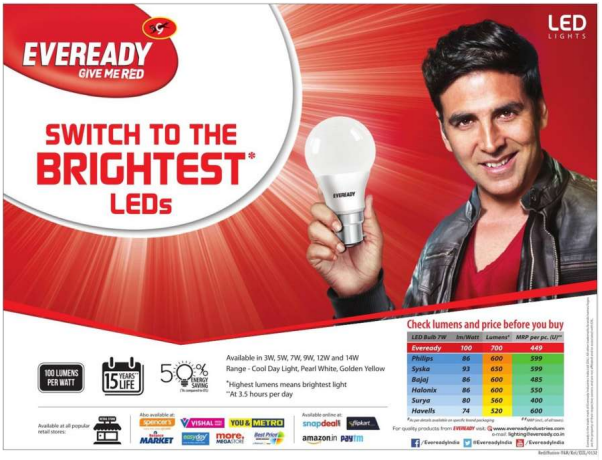Havells India Ltd. & Anr. v. Amritanshu Khaitan & Ors.
Havells India Ltd. & Anr. v. Amritanshu Khaitan & Ors.
2015 (62) PTC 64 [Del]
Brief Facts:
- Defendants released the below mentioned advertisement.

- In the said advertisement, the Defendant compared Eveready LED Bulb with Havells LED Bulb.
- Plaintiffs filed a Suit for Disparagement against the Plaintiff.
- Along with the suit, the Plaintiffs also filed an application for interim relief. The present decision is on that application.
Plaintiffs’ Contentions:
- The Statement that “check lumens and price before you buy” was an invitation to consumers to compare only two attributes of a bulb, i.e. lumens and price as if they were the only relevant for determining value of an LED Bulb.
- This comparison is selective and mischievous.
- Defendant was obliged to compare all relevant parameters.
- When it came to superiority in lumens, advertisement makes a comparison not just with Plaintiffs’ product but also with other third party products, but when it came to power factor, the Defendants shifted the comparison to one between its product (LED Bulb) and CFL Bulb instead of rival LED Bulbs.
- Defendants, by only highlighting two of the four features, attempted to leap frog over the plaintiffs‟ product by optimising only two of the four attributes and giving an impression that only two of its superior attributes are the relevant attributes.
- In support of its contentions, Plaintiffs relied upon:
- Tata Press Ltd. v. Mahanagar Telephone Nigam Ltd. and Ors.;(1995) 5 SCC 139
- Lakhanpal National Ltd. v. MRTP Commission & Anr., (1989) 3 SCC 251
- Glaxosmithkline Consumer Healthcare Ltd. v. Heinz India (P) Ltd.; MIPR 2010 (3) 314: 2009 (39) PTC 498 (Del)
- Medicare Ltd. v. Reckitt Benckiser India Limited, 2002 (24) PTC 686 (MRTP)
- Janssen Pharmaceutica Pty. Ltd. v. Pfizer Pty. Ltd., No. G220 of 1985
Defendants’ Contentions:
- Representations made in the impugned advertisement were true and justified.
- Comparative representations made in the impugned advertisement were derived from the product packaging of all companies mentioned in the said advertisement.
- Comparison of the rival products of lumens per watt, lumens and price was justified as the packaging of all the rival products did not contain all the parameters suggested by the Plaintiffs. The common features in all packaging had been mentioned in the comparative table mentioned in the advertisement. Therefore, not only was the representation made in the impugned advertisement true but the same was also justified.
- “Lumens” is a measure of total amount of visible light emitted by a light source. Therefore, the defendant No.2 was completely justified in making the representation of brightness on the basis of lumens.
- Glorifying one’s product was permissible provided the rival’s product was not denigrated.
- No case of special damage had been set up by the plaintiffs. He submitted that in order to maintain an action for disparagement, the plaintiffs would not only have to plead, but also prove a case of special damage caused as a result of the offending publication/representation.
- In support of its contentions, Plaintiffs relied upon:
- Dabur India Ltd. v. Colortek Meghalaya Pvt. Ltd. & Anr.; 2010 (42) PTC 88 (Del)
- Philips India Pvt. Ltd. v. Shree Sant Kripa Appliances Pvt. Ltd.; CS(OS) No. 1913/2014
Court’s Reasoning:
- Advertisements are not to be read as testamentary provisions in a will following Mc Donalds Hamburgers Ltd. v. Burgerking (UK) Ld.[1987] FSR 112 (Para 24)
- Public expects a certain hyperbole in advertising following Marico Ltd. v. Adani Wilmar; 2013 (54) PTC 515 (Del) (Para 24)
- Comparative advertising can be resorted to only with regard to like products. Comparative advertising is permitted when the following conditions are met:-
- goods or services meeting the same needs or intended for the same purpose;
- one or more material, relevant, verifiable and representative features (which may include price); and 3) products with the same designation of origin. (where applicable) (Para 28)
- In India law, there is no rule which requires all the features of a product have to be necessarily compared in an advertisement. (Para 35)
- In Comparative Advertising, a certain amount of disparagement is implicit following Colgate Palmolive Company & Anr. v. Hindustan Unilever Ltd., 2014 (57) PTC 47 [Del][DB] (Para 36)
- Competitors can compare but cannot mislead.
- For an advertisement to be misleading, the same must have potential to deceive and must be likely to affect the economic behaviour of the public to whom it is addressed. (Para 41)
- There is no bar in comparing CFL and LED bulbs. (Para 45)
- Lumens are a measure of brightness and one of the essential functions of a bulb is to dispel darkness. (Para 46)
- It is open to an advertiser to highlight a special feature/characteristic of his product which sets it apart from its competitors and to make a comparison as long as it is true. (Para 48)
- In other words, it is open to an advertiser to objectively compare one or more material, relevant, verifiable and representative feature of the goods and services in question which may include price. There is no requirement in law to disclose each and every factor/characteristic in comparative advertisement. (Para 49)
- Impugned advertising campaign is not misleading and there is no denigration or disparagement of plaintiffs‟ mark. Further, the factors compared are material, relevant, verifiable and representative features.
The Application was dismissed.
